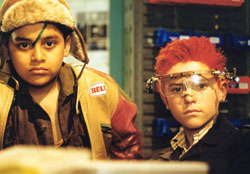 Your favourite actors boast that it is their secret weapon. Some of your friends hide a secret stash in their backpack at school. Your doctor raves about it, tells you you don’t use nearly enough.
Your favourite actors boast that it is their secret weapon. Some of your friends hide a secret stash in their backpack at school. Your doctor raves about it, tells you you don’t use nearly enough.
Enough already! What is so special about water?
Quickie Chemistry
Water molecules are shaped like this:
O | |
H | H |
With the Hydrogen (H) atoms being slightly positively charged (they are missing a negatively charged electron) and the oxygen being slightly negatively charged, the molecules are slightly polar, and cling to each other like tiny magnets, thus holding water together in droplets.
Because of its slightly polar nature, water is able to act as both a polar and a non-polar substance. It is known as a universal solvent, and, with a pH of 7 (which is sort of the ‘zero’ of pH, the most neutral pH possible), water is able to dissolve both acidic and basic substances. In fact, water can dissolve more substances than any other liquid.
Water is the only natural substance that is found in all three states—solid, liquid, and gas—within normal Earth temperatures. It is also unusual in that it expands in its solid state, or is less dense. That is to say that a volume of ice weighs less than the same volume of (liquid) water; thus, ice floats.
And it has a high specific heat index, which means that water absorbs a lot of heat before it itself becomes hot; waters slow temperature changes help to regulate seasonal changes, so that temperatures change less suddenly than they might.
Water, Water, the magical drink. The more you bathe, the less you stink.
Water’s polar quality gives it a certain kind of stickiness that you might take for granted, holding it together in small puddles rather than spreading with gravity into a molecule-thin film. Using a trick known as capillary action, water clings to other substances, for example a paper towel you might use to soak up a spill.
Plants use this capillary action to soak water up through their root systems, as sticky water literally climbs up through their fibers.
Up to 60% of the human body weight is water, with the brain being composed of 70 percent water, the blood 82%, and the lungs a surprising 90%. The cells in our body are filled with water, whose special chemical qualities help us to use nutrients, minerals and chemicals in order to complete vital biological processes. Water’s absorptive stickiness is what carries these necessary elements around our bodies. The carbohydrates and proteins that fuel our body are metabolized and transported by water in our bloodstream. Equally important is waters ability to transport waste out of our body. Thus, we are constantly releasing waste-carrying water, and must always drink more water in order to keep hydrated, and allow these processes to continue.
On a more superficial level, we are able to transport dirt and sweat (and paint or whatever other mess we’ve gotten ourselves into) off of our bodies, using these same qualities of water when we bathe, causing our dirtiness to stick to the polar water molecules as we run water over our body..
So there you have it. Good ol’ water, keeping us alive, and lookin’ good.
The Real Circle of Life
About 3/4 of the earth’s surface is covered in water. What is this crazy liquid-ie substance that fills our oceans? And how did it get there?
Well….The water is carried into the sea by rivers, whose waters come from smaller tributary streams. These streams are fed by rainwater, either direct from the sky, or in the form of ground water, which has seeped into the earth, and slowly moves downhill through the ground until entering a stream.
The rainwater comes from a high, cold part of the atmosphere. It was brought to this height by a rising warm air current that lifted the water (as vapor) from a lower, warmer part of the atmosphere, and when it cooled, the water changed from vapor to liquid. The water vapor had arrived in the lower atmosphere through a process known as evaporation, through which (liquid) surface water was heated enough to transform into vapor and rise up into the air. Where was this surface water? Well, most of it as in the ocean. …..And how did it get there?
As you can piece together, the Earth’s water is in a closed system, a cycle which brings water from the ocean, into the air, over land, down in rain, into the rivers, and back to the ocean, again. As always, this is gross oversimplification, but you get the point.
It is important to note that, while the oceans are seemingly endless, there is actually a limited supply of water on this planet. This means that we are stuck with any mess we create; the rivers we pump full of factory waste are ultimately supplying our drinking water.
For all practical purposes, water cannot be created or destroyed (though a chemist can show you this technically isn’t true, chemically creating water is not a realistically efficient solution). The water we are using today is the same water we will be using tomorrow, and in a thousand years, and on, until the earth is dust.
So…..Take good care of the water!
 Water on the brain
Water on the brain
Is it any wonder that real people and fictional characters alike obsess over water? Robert Heinlein’s characters in Stranger in a Strange Land see water as something sacred; to give someone water is the most profound gift you can give, as you are giving them life itself.
Likewise, characters in The Tribe have come to see how very special water is, and how scarce it can become despite its constant presence. Jack and Dal spend much of season one developing a usable water filter, adapting water’s sticky properties to clean it in a bath of sand, while Ebony demonstrates her wealth by swimming in a pool filled with water.
The EcoTribe have a spiritual relationship to water, as they show Mouse during her initiation ceremony. And rightfully so.
Though it may carry no color or odor or taste, water is the breath of life.

